
Piero Gilardi, Richard Serra, Hans Haacke, in: Dokumente zur aktuellen Kunst
1967-1970. Material aus dem Archiv Szeemann. Texte von Georg Jappe, Aurel
Schmidt und Harald Szeemann (Luzern: Kunstkreis AG Luzern, 1972).
No-where? Now-here!
The Molecular Books of Life – Colleges of Unreason
An idea-driven group exhibition about the practices of writing and the book on one page.
Curatorial text by Dimitrina Sevova in collaboration with Alan Roth
Introduction
“Empiricism is a mysticism and a mathematicism of concepts, but precisely one which treats the concept as object of an encounter, as a here-and-now, or rather as an Erewhon from which emerge inexhaustibly ever new, differently distributed ‘heres’ and ‘nows’. Only an empiricist could say: concepts are indeed things, but things in their free and wild state, beyond ‘anthropological predicates’.” (Deleuze)
The project draws some lines of connection which, it seems, are not often made, between the philosophy of Gilles Deleuze and Félix Guattari, and Deleuze’s beloved science-fiction novel Erewhon by Samuel Butler, 1 which remain little explored either in the academic environment or in the field of art. As well as the rarely investigated links between Deleuze and Guattari and one of the heretic students of Sigmund Freud, Otto Rank, who replaced the sexual drives of his master with the impersonal individuation of analytic practices based on object relations, who wrote about The Denial of Death, 2 which is close to how Deleuze conceptualizes vital forces in his essay, Immanence: A Life. 3 And follows the relation between Deleuze and Guattari’s machinic theory and Samuel Butler’s molecular thought in the evolution of the machinic universe. The practices of writing presuppose wild empiricism that comes from “univocal ontology,” and its space is “a mysticism and a mathematicism of concepts.” Sol LeWitt operates in a similar fashion to Deleuze’s programming when he says: “Conceptual artists are mystics rather than rationalists. They leap to conclusions that logic cannot reach.” 4 The mathematicism of a concept resonates with marvel and wonder of the reawakening mysticism in the Object relation practices and analyses of Otto Rank, in his Psychology of Difference, where he develops his concept of a pre-Oedipal “here-and-now,” a therapy of the presence that generates a maximum degree of individuation (or difference) and connectedness. Samuel Butler’s novel Erewhon is an anagram of No-where (i.e. an anagrammatic translated Utopia) from which emerge inexhaustibly ever new, differently distributed ‘heres’ and ‘nows.’ Now-here, according to Leibniz, is the potential of “all kinds of events” which is the combination of “the Now and circumstances,” with the differential elements of thought. They do not designate people, but mark events: The dynamic of individuation in the Deleuzian and Guattarian expulsive and selective force (without subject) that constituted a process and becoming.
No-where? Now-here!
The Molecular Books of Life – Colleges of Unreason
An idea-driven group exhibition project about how and why an idea(l) book can be only a single page, and explores the strange connection between writing and biopower. Unfolding in two chapters (or two episodes) it searches for micro approaches to the paradox of practices that emerge as Art Writing and Anagrammatic Writing, between writing and life and between published/exhibition – both being forms of display (movable vs. durational). The exhibition/publishing project brings together artists who actively experiment with writing and text, whose practices are at the fringe of the visual and narrative or in-between, neither visual nor narrative, always constructed by collectively exhaustive events.
No-where? Now-here! The Molecular Books of Life – Colleges of Unreason displays art practices that rupture with representative and institutionalized forms of writing and open up to the heterogeneity of productive forces, diagrammatic dynamism and the virtual potentiality of the network of text-image-work-in-progress, to the performative relations producing this process. In a Deleuzian sense, “it is a process, that is, a passage of Life that traverses both the livable and the lived.”
The project concerns itself with the aesthetics and politics of Art Writing and Anagrammatic Writing that escape the system of taxonomic classification and whose interpretation can no longer be distributed among a variety of discourses and fields. They rather perform their disintegration in critical and radical typologies, acting invisibly as non-linear fabulation on narrations and visuals. As Deleuze put it: “Writing is a question of becoming, always incomplete, always in the midst of being formed, and goes beyond the matter of any livable or lived experience.” The project engages with the emancipatory potential, the strangeness and foreignness of the mute, inorganic and immaterial nature of writing to learn to speak with vanishing terms whose in-betweenness goes beyond the livable or lived experience – only between the times and between the line and between the pages.
When it comes to artist writing, in the preface of her essay An Anagram of Ideas on Art, Form and Film, Maya Deren critically reflected that “creative activity is usually taken to be a manifesto or a statement of the theories upon which the creative work is based.” 5 Considering Deren’s remark as symptomatic, the exhibition project No-where? Now-here! The Molecular Books of Life – Colleges of Unreason interrogates the space of writing in which the aesthetic and critical implications of the practices of Art Writing can no longer be taken as a manifesto, or an artist statement, or any other forms of supplements that give theoretical support or explain the art work after the process of production. It is a practice that is no longer an object of theory. It is both the process of production, and what is being produced; both the working process and the art of work. The practice of Art Writing is even no longer a concept that tends to replace the material existence of an object in order to de-materialize it. It is no longer mere reflection, rather a metabolization that speaks with the techniques of a female ventriloquist, because the text becomes more material than ever, driven by biopower.
The exhibition No-where? Now-here! The Molecular Books of Life – Colleges of Unreason invites the audience on a journey to the unknown from no-where, which unfolds beyond the edge of the known universe to the retinal wall of now-here, and then back and forth with different intensities in the duration of each sequence with its own rhythm, speed and wonder, listed in the distances “from ‘1,000,000,000,000,000,000,000,000.00000000 miles to edge of known universe’ through celestial, geographic, then local sectors to the artist’s typewriter and glasses to ‘.00000098 miles to cornea from retinal wall,’” 6 a tripping in the repetitive loops of the Nomadic Utopianism of errant thoughts and the real experience of such a journey (not the possible experience), a link between thought and the dynamic forces of individuation where life becomes possible.
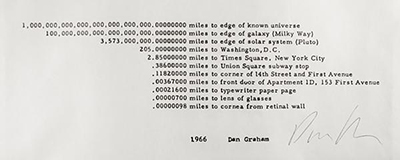
Dan Graham, March 31, 1966, 1966,
typewriter on paper, 7.9 × 22.9 cm, Daled Collection, Brussels.
Gillian Conoley, translator of Henri Michaux’s Thousand Times Broken, 7 wrote in the preface of the book: “The self? An impediment. World? Apparition. Language, marks, drawings, paintings? Failures, and with agendas of their own. Only the unknown, and within the unknown, only the uncontrollable, might be trusted.”
For Maya Deren the potentiality of practices of writing lies in “an organization of ideas in an anagrammatic complex instead of in the linear logic to which we are accustomed.” In Samuel Butler’s science fiction novel Erewhon, this potentiality is an anagrammatic complex, too, in close proximity to the Gilles Deleuze’s concept of Nomadic Utopianism, which is actualization in reverse through the practices of writing, as it stresses the passage, and process as duration. Every becoming is mortal; it is a sequence of short or vanishing concreteness of a longer process of reality and fiction.
The idea(l) book – a single page
The project gives an instruction and a further theme of aesthetic investigation and critical analysis by picking up the following paragraph from the introduction, “1. Introduction, Rhizome,” of Deleuze and Guattari’s A Thousand Plateaus: “The ideal for a book would be to lay everything out on a plane of exteriority of this kind, on a single page, the same sheet: lived events, historical determinations, concepts, individuals, groups, social formations. Kleist invented a writing of this type, a broken chain of affects and variable speeds, with accelerations and transformations, always in a relation with the outside.” 8
The project conceptualizes the book as a diagrammatic space of writing, a plane of consistency or a body that has lost its organic elements, a body which is no longer suffering, a body affirmative of itself, operative and active and at the same time mystical and obscure. The book as “a body that has become experimental, biological and physical, offering itself to question thought, with no further detours.” 9
The exhibition/publishing project No-where? Now-here! The Molecular Books of Life – Colleges of Unreason invites artists to experiment actively with their practices. What would the ideal book or a book on a single page be? How can one define the format of indefiniteness of a single page? Is it a sheet of paper, a screen, a wall, a typological abstracted space and its surface, a tract, verse or rather an interval? Is it a formalized space between the two extremes of the face and the hand? How can a body without organs be constituted, a body that has lost its organic elements, e.g., a plane, a map, a diagram, a diagonal, a short path, a long road, a broken line, a flight or a journey to the unknown? How can one think these virtual outsides and their actualizations in reverse, and “analyze language by decentering it onto other dimensions and other registers”? 10 How can one, through the practice of writing, push language as a whole “to a limit, to an outside or reverse side that consists of Visions and Auditions that no longer belong to any language.” 11
The project does not aim to give a definition of what a single page could be. This is left to the invited artists and their heterogeneous practices, techniques and ideas. All experiments with media and techniques on the idea of a book laid out on a single page are welcome, using all possible writing techniques, from typing to drawing lines by hand, or other performative techniques. Such as Man Ray’s Space Writing, in which he writes with light, evokes the concept of automatic writing, and the relation between writing and space, and expresses the unconscious. Another example could be Art & Language’s Index, a work shown at Documenta V in 1972, can be seen as the layout of one page. There are plenty of other examples and potentialities, from the finite of a page to the infinity of possibilities.
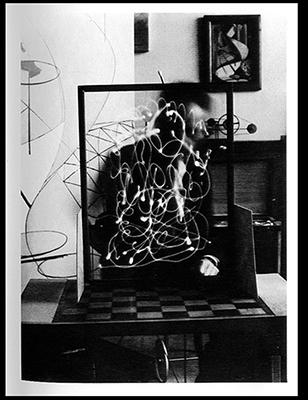
Man Ray, Space Writing (Self-Portrait),
1935. Gelatin silver print.
The project draws lines of connectivity between writing and the productive forces of dynamism of the outside, that connect the practice of writing to the logic of musical composition, which is “transforming the musical points into lines,” 12 where there are only lines and multiplicities or varieties of measurements, like in Sol LeWitt’s irregular grids that can be seen as generative matrices of pre-individual and impersonal algorithmic formations of machinic simulacra. They are a kind of structural text – diagrammatic devices of notations and instructions, which contain the radical metaphysics of mathematicism and the art of combination of the individuating differential calculus. Using diagrammatic devices and notations like running from and running after at once, Sol LeWitt found the anti-aesthetics of the politics of the grid, a kind of politics before your eyes, the politics of the imperceptible affective field, where the value is outside of the closed system of text.
“The diagram is an integral part of the work which shows the viewer that this is not just a haphazard and random and chaotic statement as it might seem if you walked into the room and saw it without any idea of the structure.” – Sol LeWitt
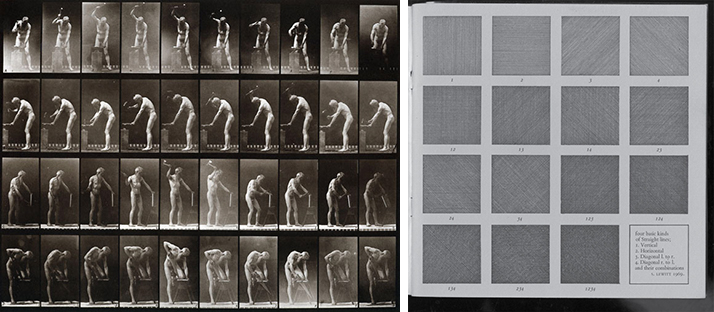
Left: Eadweard Muybridge, Animal Locomotion (Plate 491), 1887.
Collotype. Right: Sol LeWitt, Four basic kinds of straight line, 1969.
Photo-lithography. Sol LeWitt started developing his method after his encounter
with the work of photographer Eadweard Muybridge (1830–1904) in the late 1950s,
following the frames of the dissected movements of animal locomotion, repeating
the movements with lines or geometric figures playing with light and shadow to
develop the concept of the grid as a dynamic space of inorganic movement, of
abstracted algorithmic entities.
All writing involves athleticism […] of an Athlete in Bed
The exhibition/publishing project No-where? Now-here! The Molecular Books of Life – Colleges of Unreason embraces micro physics and micro desires to demand self-restrictions, close to the slogan of the minimalists of the 1960s and 1970s, less is more, and invite the participating artists to experiment with all forms of stubborn exercises of athleticism that can weaken the process of writing. All writing involves or requires some sort of athleticism – a rigorous gymnastic, a game or an exercise of an athlete in bed. “All writing involves athleticism […] this athleticism is exercised in flight and in the breakdown of the organic body – an athlete in bed, as Henri Michaux put it.” 13 The project is interested even in practices of anorexic diets that suggest eating the words with the rigorous precision of a poetic champion of hunger, in all practices that can actively waste themselves and even disappear in a surface populated by events of ephemeral existence – all events that fall outside the scope of predictable results, that fall through the grey matter, the grid, into the undifferentiated, that fall not from the negative of non-being, but from “a being implicit in those existences beyond the ground.”
The project asks how writing, freedom and biopower intersect, and how to speak of “potential,” as certain biologists do, because “health and athleticism both confront the same ambiguity” by the simple limitation of power, as Deleuze wrote. How can one break the organic body, de-naturalized it? Because in writing there is something ill, even deadly; indeed, it starts with a death. The practices of writing demand a rigorous and grueling slowing down, even the murder of one of their own becomings, in order to give freedom to a new becoming, in the sense that it opens an exit that plugs into the virtual. “S’il veut se coucher lui-même sur le papier, et non une œuvre, et non une île de soi-même, il tranche dans sa chair et voilà…” 14
Deleuze is interested in how Michaux, who once attended medical school, invented a way of writing in a language that is both “poetic” and “scientific” at the same time. And yet, Michaux takes up Rimbaud’s statement that “contemporary poetry can no longer content itself with vague lyricism, but only with total self-knowledge.” The self-knowledge of writing in which the writer is both psychoanalyst and psychoanalyzed, both critical and clinical. It is the concept of écriture, a therapeutic knowledge of how one can learn to unlearn, which contains “the impurity of writing.”
Some research materials and further references
When between 1842 and 1843, Ada Lovelace translated from Italian to English an article by Italian military engineer Luigi Menabrea on the Analytical Engine of Charles Babbage, her supplementary footnotes, written with the idea of supporting the translation of the paper, became as important as the text of the author, giving the text a new direction and shifting its meaning. She speculated that the Engine 'might act upon other things besides number, manipulate symbols and even compose elaborate and scientific pieces of music.
Deleuze’s footnotes are key to understanding his work, and often give the text a twist, a new plane of thought that can be applied as a key or a code to the encoding of the diagrammatic algorithms of the text. In the last chapter of Difference and Repetition, 15 Deleuze refers again and again to Samuel Butler’s novel Erewhon: or, Over the Range (1872). In Note 7 he writes: “Butler's Erewhon seems to us not only a disguised no-where but a rearranged now-here.” This footnote gave the present project its title.
How does the metaphysics of differential calculus function as a primary affirmation of difference, producing difference affirmed? The negative no-where transforms in repetition to an affirmative now-here, which is not a reflection that only doubles, but a diffraction that affirms difference in repetition. For Deleuze, Erewhon is the power of disguise or nomadic distribution carried out by fantastical notions. Erewhon anagrammatizes Utopia, not only translating it from Latin to English but inverting it.
Erewhon is a science-fiction book that Deleuze found so important to himself as to call it a philosophical novel. It offers a journey from the geographic coordinate system of New Zealand to Nowhere land and unfolds the mind map of a fictional state. It turned to become a road-book to the new philosophical thought of the post structuralist movement. Thus, Deleuze’s Difference and Repetition weaves a net of connections to Erewhon.

Map of part of New Zealand to illustrate Erewhon & Erewhon Revisited. Publication of original map from the Samuel Butler Collection, St. John's College, Cambridge. Approx. 1902. Drawing by "probably one of Samuel Butler's executors" according to Shaffer. Source: E. S. Shaffer, "Samuel Butler’s Fantastic Maps: Erewhon, the ‘New Jerusalem’, and the periplus of Odysseus," Word and Image 4 (1988), pp. 510-522.
Butler’s novel Erewhon is an anagram of Nowhere, which is the direct translation in English of Utopia, a term coined by Thomas More in 1516 in his book The Best State of a Republic and of the New Island Utopia, best known as only Utopia, and translated to English 1551. More who invented the world by translating literally the English "nowhere," based on Greek ou ‘not’ + topos ‘place’ into ‘modern’ Latin Utopia. In the English translation, Utopia phonetically echoes and becomes also a homophone for eutopia, which means a good place. Recalling Plato’s Republic, More called his imaginary place Utopia and made it a fictional ideal island society based on common wealth and endless work: “Wherever you are, you always have to work.” (Thomas More, Utopia) He placed the fictional island on the map somewhere in the South Atlantic Ocean near Brazil, from where the journey continues into the fictional mind diagram of Nowhere, where he mixes an imaginary or model geography and a history of the future to produce the new genre of science fiction.
More actively affirmed Utopia as “a truly golden little book, no less beneficial than entertaining,” while stating at the same time that it is a philosophical book, both political and aesthetic and scientific and poetic, which through this combination has a chance of reaching a broader audience. The story itself is a journey of a traveler called Raphael Hythloday to the new island of Utopia, from which he writes letters from No-where, in correspondence not with fictional characters but with “real people,” friends of More’s and his collaborators of the production on parts of the book itself, reporting about the fictional land through his observation and “real” experience as a witness. The name of the main protagonist, Hythloday, which can be translated as transmitter of nonsense, along with the entire situation in which he finds himself as a reporter, and many details, hint at the mockery and irony of the book.
More’s Utopia expresses the tension of its own time between the newly born governmentality and individuality, as one can say that he invented in the book some new technologies of control and biopower through surveillance, in an evolution of the apparatuses of power towards a governmentality of the Self. More remains ambiguous about the impact of these technologies, although his stance can be read as critical toward the ideal society, too: “Everyone has his eye on you, so you’re practically forced to get on with your job, and make some proper use of your spare time.” (Thomas More, Utopia) Marx took a critical stance towards the Utopian concept and Utopian Socialism. 16 He concedes, however, that “in the utopias of a Fourier, an Owen, and others, there is the anticipation and imaginative expression of a new world.” 17 Marx distinguishes in his method the scientific utopia of communism from Utopian Socialism.
Anagrams of Utopia - or anagrammatic writing
“I recommend this form to anyone who has faced the problem of compressing into a linear organization an idea which was stimulating precisely because it extended into two or three different, but not contradictory directions at once.” (Maya Deren)
Samuel Butler’s Erewhon is a double of Utopia, inverted, but not a mirror image. There are similarities only on the surface and they are different in their depth. Erewhon is a deviation of Utopia written right to left. It is neither a utopia nor a dystopia, a double but not a negative of Utopia. Rather, it is a utopia-in-a-utopia, a nomadic utopianism of the distribution of the individual and mutating lines of machinic genera in the evolution of a machinic universe, where the relation between utopia and the real has been turned upside down – the machinic simulacra of Erewhon produces the real. A part of the book builds on an article Samuel Butler had published some years earlier under the heading Darwin among the Machines. 18 Erewhon is an ironic yet serious criticism of both Marxism and Darwinism. It turns upside down the mechanisms of discipline. The institutions of the school, prison and hospital function under inverted signs. The ill or the ugly are criminalized and put in prison, their sentence proportional to their illness or ugliness. Financial speculators and thieves are treated gently and with care in the hospital. Those who try to make sense and construct a memory of history are thrown out of school. After the revolution, which starts with the demolition of the mechanical machines, the society of Erewhon evolves into a sophisticated and self-perfecting new generation machine of biopower.
One can say that the genealogy of Utopia has its obvious colonial perspectives, being linked to the new world and the new colonies; they remain in traces even in utopian projects like those of Charles Fourier, as Fourierist communities were founded in the USA in the mid-19th century. At the same time Utopia (no place/ no-where) traverses and goes beyond the colonialist lamentations and territorializations, takes a rupture with its colonialist and anthropological predicates and flees into the outside of the system and episteme of the colonial project. The nomadic utopianism of errant thought can be conceived as a rupture with the colonial project and escapism from the very notion of territory. More’s utopian journey starts from the colonies of the New World at Cabo Frio, Brazil and then turns into a journey to the unknown that goes beyond the colonizable, to the no land of science-fiction simulacra, to “the outside of the inside” in the real of the void, the swarms of thought can only pass, a peculiar journey to the end of the night, to the no-territory. Every journey to no-where is a journey in reverse, contracting the space of writing in-itself and opening to its virtual potentiality. Writing constitutes a space whose potentiality is that of repetition. In Jacques Derrida’s words, “writing is space itself and the possibility of repetition in general.” Butler’s traveler crosses the landscape of New Zealand, and finds himself displaced in the no-land of Erewhon. The traveler becomes a metaphysical roamer who encounters and observes concepts in their free and wild state, undoing the colonial genesis and going beyond the ‘anthropological predicates’ of the colonial project. In his half-imaginary travel journals of A Barbarian in Asia (1933), Henri Michaux follows Butler’s metaphysical diagram of Erewhon, as well as in the invented lands and mythical animals of his fictitious travelogues Elsewhere (1948), whose title even is a kind of reminiscence of Erewhon.
In Difference and Repetition, Deleuze first conceptualized actualization in reverse on the basis of the diagrammatic anagram of Erewhon. Throughout his body of writing he returns to this concept which, being simultaneously clear and obscure, is close to Maya Deren’s anagram in which “the logic of the whole remains intact.” The anagram of Erewhon is in the passage between the two extremes or the two dialectics – let’s call it formless and ungrounded nomadic utopianism, or nomadic distribution. Maya Deren gives instructions on how to produce the anagram in the fold of the text: “one may slice through on the diagonal, picking up the sides afterwards.” This sort of short diagonal vectors of machinic genera run in all directions through the text of Erewhon. These lines of flight produce unexpected transversal connections and generate a new vocabulary that gives trajectories to the new heretic ideas in Butler’s novel, e.g., that one can “exist as a work of art,” which Foucault later conceptualized further as the aesthetics of existence.
The anagram of Erewhon or Nomadic Utopianism has the power of fiction to “overturn the model.” The nomadic utopia of Erewhon does not aim to describe the ideal socio-politico-legal system, but to invent an idea(l) book, the fiction of philosophy and philosophy of fiction, the molecular book of life, the ideal body without organic elements. As a book it is a plane of consistency of flat multiplicities of n dimensions, a machine.
“An anagram is a combination of letters in such a relationship that each and every one is simultaneously an element in more than one linear series. This simultaneity is real, and independent of the fact that it is usually perceived in succession. And, conversely, the whole is so related to every part that whether one reads horizontally, vertically, diagonally or even in reverse, the logic of the whole is not disrupted, but remains intact." (Maya Deren, Essential Deren : Film Poetics, An Anagram of Ideas on Art, Form and Film)
Utopia’s new foreign language and its cryptic and secret geometric letters (a new language needs a new sign system)
On the opening pages of the golden Utopia book Thomas More displays the new Utopian alphabet and a secret script written with it, elaborated in collaboration with his close friend Pieter Gillis, a printer and “graphic designer” who makes an appearance in Book I of Utopia as a fictional character. Indeed More dedicated Utopia to him. The Utopian alphabet is the fictional system of signs of the fictional language of the fictional society inhabiting the fictional no land of Utopia. It is a poetic and extremely strange and foreign language. At the same time, the cryptographic alphabet expressed the temptation of a new language and the desires for a new politics and for change, leaving behind the domination of written Latin, in which the main body of Utopia was nonetheless written. It can also be seen as an anticipation of the new machinic fictional languages, or artificial languages. The alphabet may be reminiscent of some ancient Asian scripts but is no appropriation and consists of a set of newly created diagrammatical dynamic spatial geometrical empty forms. They rather anticipate the perforation cards conceived later by Ada Lovelace to encode sequential operational instructions for the first computer, Babbage’s Analytical Engine. More includes on the opening pages of the book a verse written in the new utopian language, in the new alphabet. Unlike Plato’s Republic, which denies poetry the power of the false and leaves no place for poets in its ideal state, More’s Utopia starts with a poem.
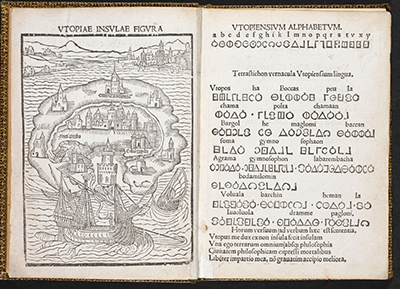
Opening pages of Thomas More, The Best
State of a Republic and of the New Island Utopia (Leuven: Dirk Martens,
1516).
![]()
The Utopian alphabet (VTOPIENSIVM ALPHABETVM)

The new alphabet, which appears More’s Utopia.
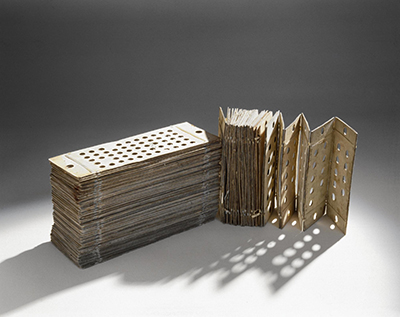
Perforation cards to be used with the Analytical Engine, c.
1879. Photo: Science Museum/SSPL
Going back to the Deleuzian and Guattarian concept of minor and foreign language within written language, the language of the other, there are plenty of references one can start from. Or, like Philippe Sollers who wrote about letters ‘liberated from language’ in Michaux’ alphabetic sheets (like his Alphabet of 1927), which Michaux called the ‘words of others.’ Michaux is also among the key references of Deleuze and Guattari. His alphabets recall ancient, indecipherable texts. Another could be Antonin Artaud’s minor and extremely singular while at the same time impersonal language of eTReTé, whose approach lay in bastardization or the decomposition of the language to the extent that it became a kind of foreign language, in the fall of letters that makes words breathe. Artaud invented the a-syn-tactical limit toward which all language tends, revealing that outside of the language. Joyce’s new language in the mode of an Enquiry or Questionnaire is method of doubt that leaves no certainty, sees transcendental, metaphysical, ontological horizons or scopes from where all creativity becomes, hence the form of writing which is nothing but the question “What is writing?” The very question undergoes a radical metamorphosis in the process of writing. In incomplete open cubes by Sol Lewitt, language becomes a material and concrete “sculptural” and “installative architectonics or a structure occupying the space in its striking incompleteness, filling the space with silence or emptiness, as in John Cage’s method of composition.
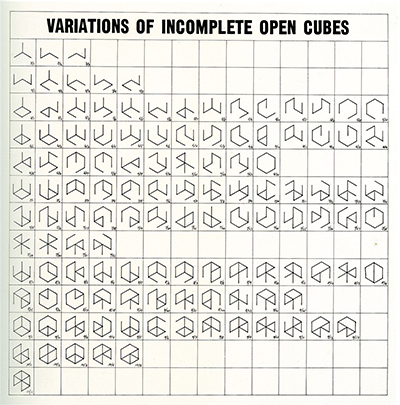
Sol Lewitt, schematic drawings for incomplete
open cubes, 1974.
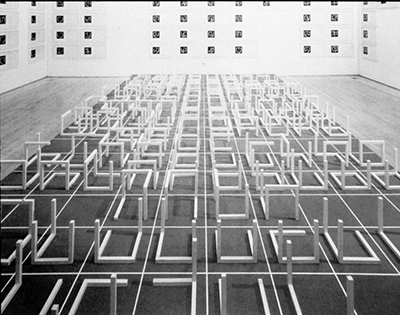
Sol Lewitt, incomplete open cubes,
an architectonic alphabetic installative structure, 1974.

Henri Michaux, an alphabetic choreography of Mouvement of cryptographic hand-writing.
1 Samuel Butler, Erewhon: or, Over the Range (London: A. C. Fifield, 1910/1872) <http://www.gutenberg.org/files/1906/1906-h/1906-h.htm> (accessed 2016-02-27).
2 Ernest Becker, The Denial of Death (New York: Simon & Schuster, 1973). Becker’s book is strongly influenced by Otto Rank’s ideas.
3 Gilles Deleuze, “Immanence: A Life,” in: Two Regimes of Madness (New York: Semiotexte, 2006).
4 Sol Lewitt, “Paragraphs on Conceptual Art.” First published in Art Forum (June 1967).
5 Maya Deren, Essential Deren: Film Poetics, An Anagram of Ideas on Art, Form and Film, ed. Bruce McPherson (Kingston/NY: Documentext, 2004).
6 Lucy Lippard on Dan Graham’s March 31, 1966, in Lucy R. Lippard, Six Years: The Dematerialization of the Art Object from 1966 to 1972; a cross-reference book of information on some esthetic boundaries … (New York: Praeger, 1973), p. xvi.
7 Henri MIchaux, Thousand Times Broken, trans. Gillian Conoley (San Francisco/CA: City Lights Books, 2014).
8 Gilles Deleuze and Félix Guattari, A Thousand Plateaus: Capitalism and Schizophrenia, trans. Brian Massumi (Minneapolis/MN: University of Minnesota Press, 1987), p. 9.
9 Henri Michaux, Michaux Œuvres complètes, p. 1326.
10 Deleuze/Guattari, op. cit., p. 8.
11 Gilles Deleuze, “Literature and Life,” in id., Essays Critical and Clinical, trans. Daniel W. Smith and Michael A. Greco (London and New York: Verso, 1998), p. 5.
12 Deleuze/Guattari, ibid., p. 8.
13 Gilles Deleuze, “Literature and Life,” op. cit.
14 “If he wants to lay down himself on the paper, rather than a work, rather than an island of himself, he will cut into his flesh, and here you go…” Henri Michaux (1926), quoted on the flap text of Œuvres completes II.
15 Gilles Deleuze, Difference and Repetition, trans. Paul Patton (New York: Columbia University Press, 1994 (1968)).
16 Karl Marx, The Poverty of Philosophy (London: Martin Lawrence, 1956 (1847)).
17 Karl Marx on Proudhon, in a letter to Kugelmann, 9 October 1866.
18 Cellarius (pseudonym of Samuel Butler’s), “Darwin among the Machines,” Press Newspaper (Christchurch, 13 June 1863).
This text in PDF format (PDF, 997KB).
